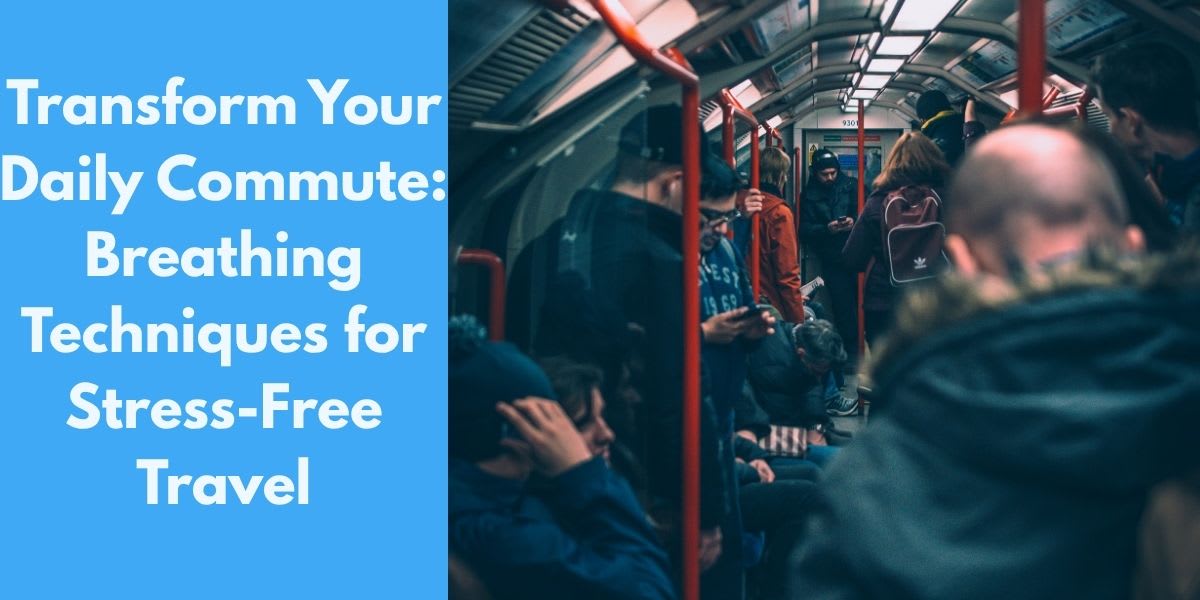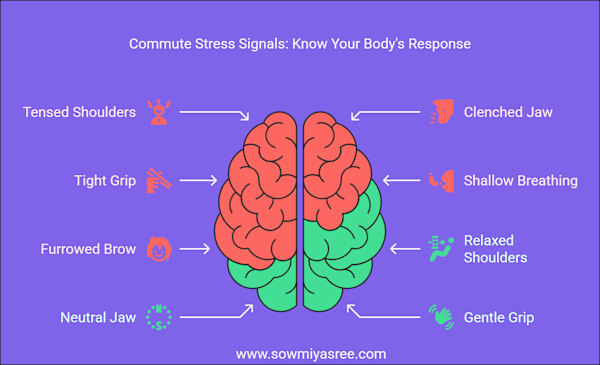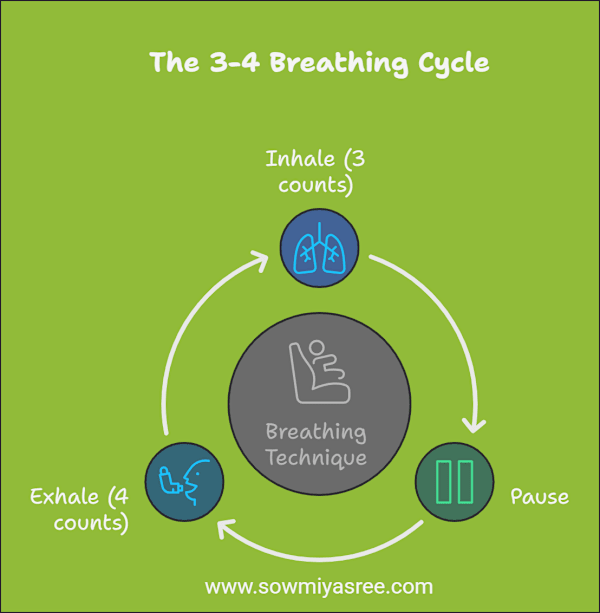The average American loses 54 hours – more than two full days – stuck in traffic each year, according to 2019 data. This transforms peaceful morning energy into commute stress when you step onto busy roads. But those 20-40 minutes of daily transit don't have to drain your energy and patience.
Instead, by changing how you approach this unavoidable part of your day, your commute can become a valuable period of peace that helps you transition between home and work. This can essentially create perfect "me time" in an otherwise busy schedule.
Mindful commuting techniques can transform this experience entirely.
⏱️ 8 min read
💡Quick Summary
──────────────
- Daily commutes waste 54 hours per year for average Americans
- The 3-4 breathing technique transforms stress into calm
- Key steps: notice stress, reset posture, breathe intentionally
- Practice consistently for 2 weeks to see measurable results
- Normal frequency: Use at every red light or moment of frustration
- Warning signs: White-knuckling the steering wheel, shallow breathing
- Solution: 3 counts in, 4 counts out breathing pattern
──────────────
📋 Table of Contents
- What is Commute Transformation? A Guide to Stress-Free Commuting
- The Path to Commute Transformation
- Best Practices for Commute Transformation
- Frequently Asked Questions About Commute Transformation
- Helpful Tools and Resources
- Conclusion
🚌What is Commute Transformation? A Guide to Stress-Free Commuting
Commute transformation is the process of intentionally transforming travel time from a stressful experience into a mindful transition period. It's not about changing external circumstances like traffic patterns or transit schedules—it's about changing your internal response to them.
This is important in this target-oriented work life. Research shows that commuting stress increases cortisol levels, raising blood pressure and heart rate while lowering productivity and mood upon arrival.
Breathing techniques for commuters have significantly reduced cortisol levels, even during rush hour traffic. By transforming your commute, you're essentially creating a better start for your work
Now, let's dive into exactly how you can create this transformation in your daily life.
🛣️The Path to Commute Transformation
Recognize Your Stress Patterns
Before you can transform your commute, you need to notice what happens in your body when you travel. The next time you enter your car or step onto public transit, pause momentarily.
- Is your breath short and tight?
- Are your shoulders creeping toward your ears?
- Is your jaw clenched?
Most people don't realize how their bodies physically respond to the anticipation of traffic. Your breathing might become shallow, your muscles tense, and your thoughts race – all before you've even encountered a single red light or crowded train car.
If you want to develop this awareness further, check out my guide on Spotting Your Breathing Habits: A Complete Guide to Conscious Breath Awareness
This awareness is powerful because it allows you to intervene before stress escalates. By recognizing your unique stress patterns, you create a brief moment of choice rather than automatically falling into reaction mode.
Try setting a reminder on your phone for the start of your commute that simply asks: "How am I breathing right now?" This small prompt can break the autopilot of stress before it takes over.
Let's consider how to use this awareness to reset your commuting experience.
🧍Reset Your Posture
Once you've noticed tension in your body, the next step is incredibly simple yet effective: adjust your sitting position. Even in a car seat or crowded subway car, you can make small changes that signal safety to your nervous system.
Start by sitting comfortably in your seat with your back supported. Then, consciously soften your shoulders away from your ears. Relax your jaw by slightly parting your teeth, and ensure your grip on the steering wheel or handrail isn't white-knuckled.
These physical adjustments matter because your body and mind are in constant communication. When your body is tense, it sends danger signals to your brain, which responds with more stress hormones. Breaking this cycle starts with your physical stance.
Drivers should try setting up their car environment to promote calm. Consider keeping your favorite essential oil (like lavender or orange) in a car diffuser or playing music that energizes without agitating.
Now that your body is more relaxed, it's time to address your breathing directly.
🍃Breathe Intentionally: The 3-4 Breathing Technique for Commuters
The cornerstone of commute transformation is intentional breathing. This isn't a complicated meditation—it's a simple pattern anyone can use while safely operating a vehicle or sitting on public transportation.
Here's the pattern:
- Inhale through your nose for 3 counts
- Pause naturally at the top of your breath
- Exhale through slightly pursed lips for 4 counts
- Repeat whenever you feel irritated with traffic
[Image: Circular diagram showing the 3-4 breathing technique: Inhale (3 counts) → Pause → Exhale (4 counts)]
This specific breathing ratio—with the exhale slightly longer than the inhale—activates the parasympathetic nervous system, which is responsible for "rest and digest" functions. Simply, it tells your body, "You're safe to relax in motion."
For more on how different breathing patterns affect your energy, see my article on The Breath-Energy Connection: Powerful Ways to Boost Your Natural Vitality
Unlike fighting traffic stress with distractions like loud music or phone calls (which can actually increase your stress load), this breathing pattern:
- Lowers stress hormones naturally
- Keeps you alert yet calm
- Creates a mental boundary between spaces
- Builds resilience to travel delays
The beauty of this technique is that no one around you will even notice you're doing it.
So, practice mindful commuting daily. Consistency turns these commute stress reduction techniques into habits that automatically activate when you enter a traffic mess.
With consistent practice, this technique becomes your default response to commuting challenges.
🚦Best Practices for Commute Transformation
Here are some expert-recommended practices to take your commute transformation to the next level:
Create transition rituals: Take 30 seconds to set an intention before starting your commute and another deep breath before exiting. Add small boundary markers, like switching playlists or saying, "Now I'm heading to work/home," to mentally prepare for environment changes.
Embrace single-tasking: Rather than multitasking during your commute, give your full attention to simply being in transit. This mindful presence enhances the calming effects of your breathing practice.
Manage external stressors: Check traffic apps before—not during—your commute to avoid continuous stress triggers. Prepare for known delay points in advance.
Gradually extend your practice: Start with 2-3 minutes of intentional breathing during your commute, then slowly increase until it becomes your default state while in transit.
For more guidance on optimizing breathing for specific activities, read my guide on Activity-Specific Breathing Patterns: A Complete Guide to Optimizing Your Performance
Let's explore how to overcome common challenges to this practice.
🔧Helpful Tools and Resources
These resources can enhance your stress-free commuting practice and help you master mindful driving techniques:
- Breathwrk (Free with premium options): A mobile app offering guided breathing exercises specifically designed for different situations, including a "Calm" program perfect for commuting.
- Insight Timer (Free with premium options): Features short guided meditations designed for commuters, including specific tracks for driving anxiety.
- Headspace's "On-the-Go" meditation (Subscription required) is a short, eyes-open meditation designed specifically for commuting scenarios.
- Stress-tracking wearables like Garmin and Fitbit (Various prices): Many modern fitness trackers include stress monitoring features that can help you objectively measure how your commute affects your physiology.
With these tools, you can enhance your practice and gain deeper insights into your transformation.
Once you've mastered the 3-4 breathing technique and transformed your commute, you might also want to explore how breathing exercises can energize your mornings. Check out Morning Breathing Exercises: A Science-Backed Alternative to Coffee for Natural Energy
❓Frequently Asked Questions About Commute Transformation
How can I remember to practice breathing techniques during my stressful commute?
Link your commute stress reduction practice to automatic triggers like stopping at red lights or hearing horns. Set location-based reminders on your phone for specific points in your route where mindful commuting would be most beneficial.
Can I use stress-free commuting techniques when carpooling or on public transit?
Yes! The 3-4 breathing technique for commuters is subtle enough that others won't notice. It works across all transportation modes and is especially effective during transition points between them.
How quickly will commute transformation techniques reduce my stress levels?
Many people notice immediate stress reduction after just one session of mindful commuting. The cumulative benefits of these breathing exercises for traffic stress typically become noticeable after about two weeks of consistent practice.
Will breathing techniques for commuters make me too relaxed to drive safely?
No—the 3-4 breathing pattern actually enhances commuter safety by improving focus and reaction time. By reducing stress hormones like cortisol, this stress-free commuting strategy helps eliminate mental fog, making you a more attentive driver.
How can I track whether my commute transformation is actually working?"
Track your commute transformation using a simple 1-5 stress level scale at the beginning and end of each journey. As you master these mindful commuting techniques, notice improvements in your arrival state and how your reactivity to traffic incidents changes.
How do I apply breathing exercises during unexpected traffic delays?
Unexpected disruptions are perfect opportunities to practice stress-free commuting. When encountering a sudden traffic jam, notice your initial stress response, then intentionally shift to the 3-4 breathing pattern, focusing on what you can control rather than the delay itself.
📌Conclusion
Your daily commute doesn't have to be wasted time or a source of frustration. By implementing the simple technique of intentional breathing during transit, you can transform those 54 hours per year from a stress-inducing experience into a valuable transition space that benefits your entire day.
Remember that this transformation doesn't require changing external circumstances – it's about changing your relationship with an unavoidable part of modern life. Through consistent practice, you'll likely notice a calmer commute, an improved mood upon arrival, greater resilience to travel delays, and a clearer boundary between your work and home life.
With regular practice of these breathing exercises for traffic stress, your commute becomes more than just travel time—it becomes an opportunity for rejuvenation that benefits your entire day.
The journey between places can be just as important as the destinations themselves. Your commute can become a pocket of peace in your busy day – all it takes is a few mindful breaths to get started.
──────────────
🪶Written by Sowmiya Sree | Breath Researcher & Author of "Evolution of Breath"
This article was last updated: February 2025
Note: This article is informational and does not constitute medical advice. Always consult your healthcare provider for medical concerns.
Photo by Alexandre Debiève on Unsplash


